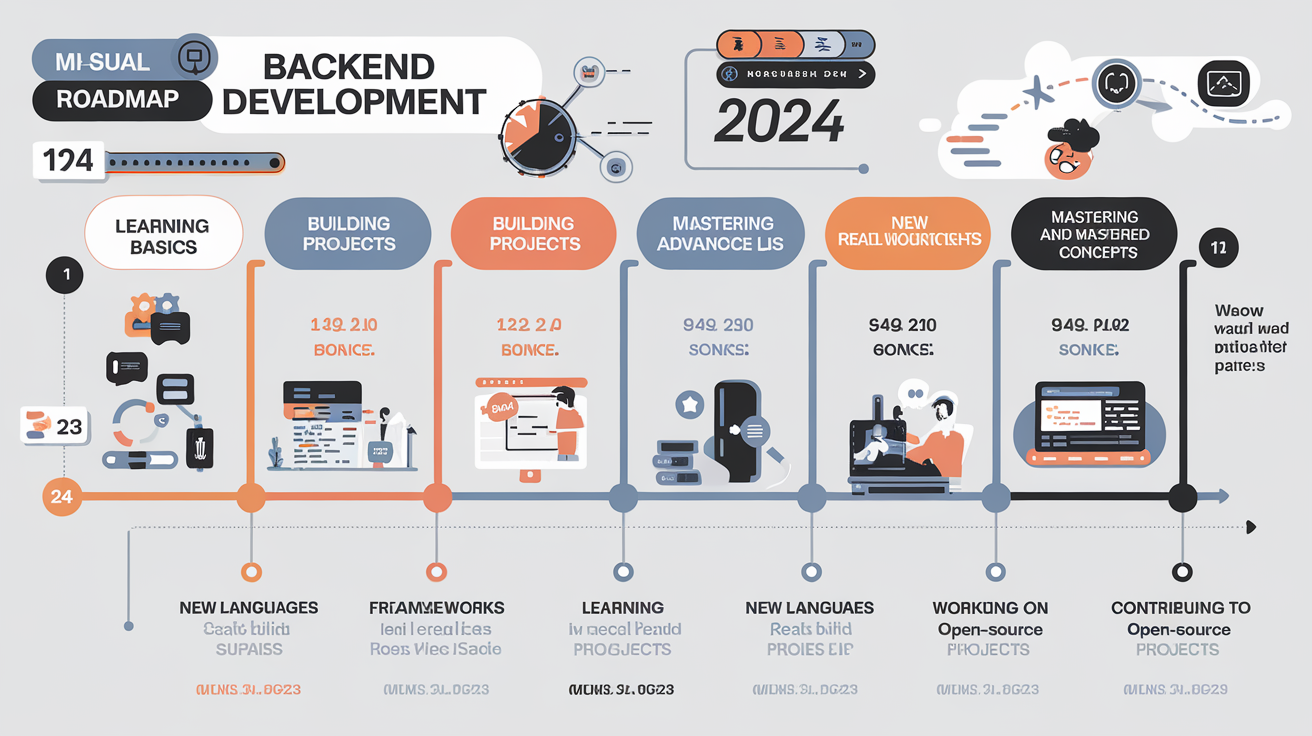As the digital landscape continues to evolve, backend development remains the cornerstone of building robust and scalable web applications. Whether you’re an aspiring developer or a seasoned professional looking to sharpen your skills, having a clear roadmap is essential. In 2024, the backend development landscape is more dynamic than ever, with new technologies and best practices emerging. This guide will walk you through the essential skills and technologies you need to master to excel in backend development.
1. Learn a Programming Language
The foundation of backend development starts with mastering at least one programming language. Languages like Python, JavaScript (Node.js), Ruby, or Java are popular choices due to their wide adoption and strong community support.
Mastering the Language: Focus on understanding the syntax, data types, control structures, and object-oriented programming concepts of your chosen language. This will enable you to write efficient and maintainable code.
Popular Backend Languages: Python is known for its simplicity and readability, making it a great choice for beginners. Node.js, powered by JavaScript, is favored for building scalable network applications. Java and Ruby are also widely used in enterprise-level applications.
2. Databases
Databases are the backbone of any backend system, storing and managing data effectively.
Relational Databases: Learning SQL (Structured Query Language) is crucial for working with relational databases like MySQL or PostgreSQL. These databases are known for their strong consistency and ability to handle complex queries.
NoSQL Databases: In addition to relational databases, explore NoSQL options like MongoDB or Firebase. NoSQL databases are designed for non-relational data storage, offering flexibility in handling large volumes of unstructured data.
3. Web Servers
Understanding how web servers function is critical for backend developers, as they are responsible for handling HTTP requests and serving web content.
Server Basics: Familiarize yourself with popular web servers like Apache or Nginx. Learn how they handle requests and manage server resources.
Advanced Topics: Delve into load balancing, reverse proxying, and server optimization to ensure your web applications can handle high traffic volumes efficiently.
4. API Development
APIs (Application Programming Interfaces) are the bridges between different software components, enabling them to communicate effectively.
RESTful APIs: Learn about REST (Representational State Transfer) APIs and how to design them. RESTful APIs are stateless and provide a standardized way of interacting with web services.
HTTP Methods and Status Codes: Understand the different HTTP methods (GET, POST, PUT, DELETE) and status codes (200 OK, 404 Not Found) to build robust APIs.
API Frameworks: Implement API endpoints using frameworks like Flask (Python), Express.js (Node.js), or Ruby on Rails. These frameworks simplify the process of building and managing APIs.
5. Authentication & Authorization
Security is paramount in backend development, especially when dealing with user data and permissions.
Authentication Mechanisms: Study authentication mechanisms such as JWT (JSON Web Tokens) or OAuth. These methods help in securely identifying users and managing sessions.
Password Security: Learn about password hashing techniques to securely store user passwords. Implementing strong encryption practices is essential to prevent data breaches.
6. Caching
Caching is a powerful technique to improve the performance of your applications by reducing the load on databases and servers.
Caching Basics: Understand how caching works and its role in enhancing application speed.
Tools for Caching: Explore tools like Redis or Memcached for caching frequently accessed data. These in-memory data stores are designed to deliver rapid data retrieval
7. Testing & Debugging
Testing and debugging are critical aspects of the development process, ensuring that your code is reliable and bug-free.
Testing Frameworks: Gain knowledge of testing frameworks like Jest (JavaScript), PyTest (Python), or JUnit (Java). These frameworks help automate testing processes, making it easier to maintain code quality.
Debugging Techniques: Learn how to identify and fix issues in your code. Effective debugging involves tracing errors back to their source and understanding the root cause.
8. Version Control
Version control systems are essential for managing code changes and collaborating with other developers.
Git Mastery: Familiarize yourself with Git, the most popular version control system. Learn how to commit changes, create branches, and merge code.
Collaboration Platforms: Use platforms like GitHub or Bitbucket to collaborate with other developers. These platforms provide tools for code review, issue tracking, and project management.
9. Security
Security is a crucial consideration in backend development, protecting your applications from vulnerabilities and attacks.
Common Vulnerabilities: Understand common security vulnerabilities and best practices for securing web applications. Topics include Cross-Site Scripting (XSS), SQL injection, and data encryption.
Advanced Security Practices: Learn about input validation, output encoding, and secure data storage. Implementing these practices will help safeguard your applications against malicious attacks.
10. Deployment & DevOps
Once your application is developed, it needs to be deployed in a reliable and scalable manner.
Deployment Tools: Learn about deployment processes and tools like Docker or Kubernetes. These tools allow you to package your applications in containers, making them portable and easy to deploy.
CI/CD Pipelines: Understand continuous integration and continuous deployment (CI/CD) pipelines to automate the deployment process. CI/CD pipelines help streamline the process of building, testing, and deploying code.
Conclusion: The Ultimate Backend Development Roadmap for 2024
Backend development in 2024 requires a comprehensive understanding of various tools, languages, and best practices. By following this roadmap, you’ll be well-equipped to build robust, secure, and scalable backend systems. Stay updated with the latest trends and continuously refine your skills to stay ahead in the ever-evolving field of backend development.


















